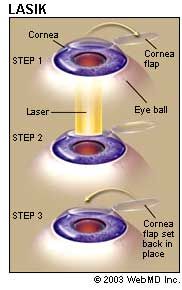LASIK, which stands for laser in-situ keratomileusis, is a popular surgery used to correct vision in people who are
nearsighted,
farsighted, or have
astigmatism.
All
laser vision correction surgeries work by reshaping the cornea, the
clear front part of the eye, so that light traveling through it is
properly focused onto the retina located in the back of the eye. LASIK
is one of a number of different surgical techniques used to reshape the
cornea.
What Are the Advantages of LASIK Eye Surgery?
LASIK has many benefits, including:
- It
works! It corrects vision. Around 96% of patients will have their
desired vision after LASIK. An enhancement can further increase this
number.
- LASIK is associated with very little pain due to the numbing drops that are used.
- Vision is corrected nearly immediately or by the day after LASIK.
- No bandages or stitches are required after LASIK.
- Adjustments can be made years after LASIK to further correct vision if vision changes while you age.
- After
having LASIK, most patients have a dramatic reduction in eyeglass or
contact lens dependence and many patients no longer need them at all.
What Are the Disadvantages of LASIK Eye Surgery?
Despite the pluses, there are some disadvantages to LASIK eye surgery:
- Changes made to the cornea cannot be reversed after LASIK.
- LASIK is technically complex. Problems may occur when the doctor creates the flap, which can permanently affect vision.
- LASIK
can rarely cause a loss of "best" vision. Your best vision is the
highest degree of vision that you achieved while wearing your contacts
or eyeglasses.
What Are the Potential Side Effects of LASIK Eye Surgery?
Some
patients experience discomfort in the first 24 to 48 hours after LASIK
eye surgery. Other side effects, although rare, may include:
- Glare
- Seeing halos around images
- Difficulty driving at night
- Fluctuating vision
- Dry eyes
How Should I Prepare for LASIK Eye Surgery?
Before
LASIK eye surgery, you will meet with a coordinator or eye surgeon who
will discuss what to expect during and after the procedure. During this
session, your medical history will be evaluated and your eyes will be
fully examined. Likely initial tests include measuring corneal
thickness, refraction, corneal mapping, air pressure, and pupil
dilation. Once you have gone through the initial evaluation, you will
meet the surgeon, who will answer any questions you may have.
Afterwards, you can schedule an appointment for the procedure.
If
you wear rigid gas permeable contact lenses, you should not wear them
for at least three weeks before your evaluation. Other types of contact
lenses shouldn't be worn for at least three days prior to the
evaluation. Be sure to bring your eyeglasses to the surgeon so your
prescription can be reviewed.
On the day of your
surgery, eat a light meal before going to the doctor and take all of
your prescribed medications. Do not wear eye makeup or have any bulky
accessories in your hair that will interfere with positioning your head
under the laser. If you are not feeling well that morning, call the
doctor's office to determine whether the procedure needs to be postponed



